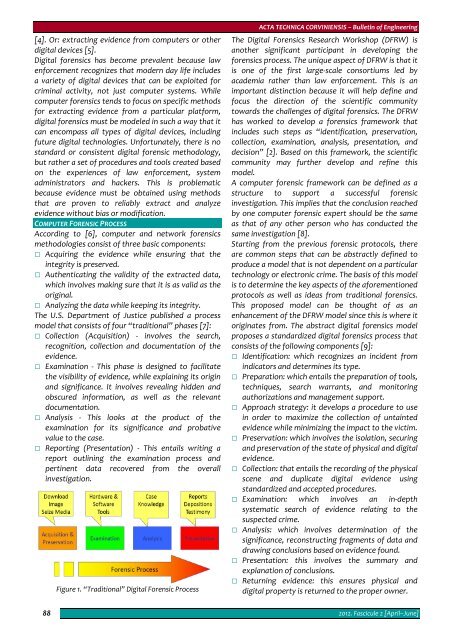Editorial & Advisory Board - Acta Technica Corviniensis
Editorial & Advisory Board - Acta Technica Corviniensis
Editorial & Advisory Board - Acta Technica Corviniensis
You also want an ePaper? Increase the reach of your titles
YUMPU automatically turns print PDFs into web optimized ePapers that Google loves.
[4]. Or: extracting evidence from computers or other<br />
digital devices [5].<br />
Digital forensics has become prevalent because law<br />
enforcement recognizes that modern day life includes<br />
a variety of digital devices that can be exploited for<br />
criminal activity, not just computer systems. While<br />
computer forensics tends to focus on specific methods<br />
for extracting evidence from a particular platform,<br />
digital forensics must be modeled in such a way that it<br />
can encompass all types of digital devices, including<br />
future digital technologies. Unfortunately, there is no<br />
standard or consistent digital forensic methodology,<br />
but rather a set of procedures and tools created based<br />
on the experiences of law enforcement, system<br />
administrators and hackers. This is problematic<br />
because evidence must be obtained using methods<br />
that are proven to reliably extract and analyze<br />
evidence without bias or modification.<br />
COMPUTER FORENSIC PROCESS<br />
According to [6], computer and network forensics<br />
methodologies consist of three basic components:<br />
Acquiring the evidence while ensuring that the<br />
integrity is preserved.<br />
Authenticating the validity of the extracted data,<br />
which involves making sure that it is as valid as the<br />
original.<br />
Analyzing the data while keeping its integrity.<br />
The U.S. Department of Justice published a process<br />
model that consists of four “traditional” phases [7]:<br />
Collection (Acquisition) ‐ involves the search,<br />
recognition, collection and documentation of the<br />
evidence.<br />
Examination ‐ This phase is designed to facilitate<br />
the visibility of evidence, while explaining its origin<br />
and significance. It involves revealing hidden and<br />
obscured information, as well as the relevant<br />
documentation.<br />
Analysis ‐ This looks at the product of the<br />
examination for its significance and probative<br />
value to the case.<br />
Reporting (Presentation) ‐ This entails writing a<br />
report outlining the examination process and<br />
pertinent data recovered from the overall<br />
investigation.<br />
Figure 1. “Traditional” Digital Forensic Process<br />
ACTA TECHNICA CORVINIENSIS – Bulletin of Engineering<br />
The Digital Forensics Research Workshop (DFRW) is<br />
another significant participant in developing the<br />
forensics process. The unique aspect of DFRW is that it<br />
is one of the first large‐scale consortiums led by<br />
academia rather than law enforcement. This is an<br />
important distinction because it will help define and<br />
focus the direction of the scientific community<br />
towards the challenges of digital forensics. The DFRW<br />
has worked to develop a forensics framework that<br />
includes such steps as “identification, preservation,<br />
collection, examination, analysis, presentation, and<br />
decision” [2]. Based on this framework, the scientific<br />
community may further develop and refine this<br />
model.<br />
A computer forensic framework can be defined as a<br />
structure to support a successful forensic<br />
investigation. This implies that the conclusion reached<br />
by one computer forensic expert should be the same<br />
as that of any other person who has conducted the<br />
same investigation [8].<br />
Starting from the previous forensic protocols, there<br />
are common steps that can be abstractly defined to<br />
produce a model that is not dependent on a particular<br />
technology or electronic crime. The basis of this model<br />
is to determine the key aspects of the aforementioned<br />
protocols as well as ideas from traditional forensics.<br />
This proposed model can be thought of as an<br />
enhancement of the DFRW model since this is where it<br />
originates from. The abstract digital forensics model<br />
proposes a standardized digital forensics process that<br />
consists of the following components [9]:<br />
Identification: which recognizes an incident from<br />
indicators and determines its type.<br />
Preparation: which entails the preparation of tools,<br />
techniques, search warrants, and monitoring<br />
authorizations and management support.<br />
Approach strategy: it develops a procedure to use<br />
in order to maximize the collection of untainted<br />
evidence while minimizing the impact to the victim.<br />
Preservation: which involves the isolation, securing<br />
and preservation of the state of physical and digital<br />
evidence.<br />
Collection: that entails the recording of the physical<br />
scene and duplicate digital evidence using<br />
standardized and accepted procedures.<br />
Examination: which involves an in‐depth<br />
systematic search of evidence relating to the<br />
suspected crime.<br />
Analysis: which involves determination of the<br />
significance, reconstructing fragments of data and<br />
drawing conclusions based on evidence found.<br />
Presentation: this involves the summary and<br />
explanation of conclusions.<br />
Returning evidence: this ensures physical and<br />
digital property is returned to the proper owner.<br />
88<br />
2012. Fascicule 2 [April–June]

















